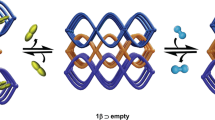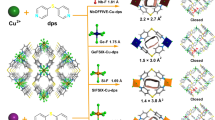Abstract
Metal organic frameworks (MOFs) are particularly exciting materials that couple porosity, diversity and crystallinity. But although they have been investigated for a wide range of applications, MOF chemistry focuses almost exclusively on properties intrinsic to the empty frameworks; the use of guest molecules to control functions has been essentially unexamined. Here we report Na3(2,4,6-trihydroxy-1,3,5-benzenetrisulfonate) (named β-PCMOF2), a MOF that conducts protons in regular one-dimensional pores lined with sulfonate groups. Proton conduction in β-PCMOF2 was modulated by the controlled loading of 1H-1,2,4-triazole (Tz) guests within the pores and reached 5 × 10−4 S cm−1 at 150 °C in anhydrous H2, as confirmed by electrical measurements in H2 and D2, and by solid-state NMR spectroscopy. To confirm its potential as a gas separator membrane, the partially loaded MOF (β-PCMOF2(Tz)0.45) was also incorporated into a H2/air membrane electrode assembly. The resulting membrane proved to be gas tight, and gave an open circuit voltage of 1.18 V at 100 °C.
This is a preview of subscription content, access via your institution
Access options
Subscribe to this journal
Receive 12 print issues and online access
$259.00 per year
only $21.58 per issue
Buy this article
- Purchase on Springer Link
- Instant access to full article PDF
Prices may be subject to local taxes which are calculated during checkout






Similar content being viewed by others
References
Kitagawa, S. & Matsuda, R. Chemistry of coordination space of porous coordination polymers. Coord. Chem. Rev. 251, 2490–2509 (2007).
Yaghi, O. M. et al. Reticular synthesis and the design of new materials. Nature 423, 705–714 (2003).
Mueller, U. et al. Metal–organic frameworks- prospective industrial applications. J. Mater. Chem. 16, 626–636 (2006).
Collins, D. J. & Zhou, H. C. Hydrogen storage in metal-organic frameworks. J. Mater. Chem. 17, 3154–3160 (2007).
Choi, H. J., Dinca, M. & Long, J. R. Broadly hysteretic H2 adsorption in the microporous metal-organic framework Co(1,4-benzenedipyrazolate). J. Am. Chem. Soc. 130, 7848–7850 (2008).
Wang, B., Côté, A. P., Furukawa, H., O'Keeffe, M. & Yaghi, O. M. Colossal cages in zeolitic imidazolate frameworks as selective carbon dioxide reservoirs. Nature 453, 207–211 (2008).
Vaidhyanathan, R., Iremonger, S. S., Dawson, K. W. & Shimizu, G. K. H. An amine-functionalized metal organic framework for preferential CO2 adsorption at low pressures. Chem. Commun. 5230–5232 (2009).
Ma, S. Q. et al. Metal-organic framework from an anthracene derivative containing nanoscopic cages exhibiting high methane uptake. J. Am. Chem. Soc. 130, 1012–1016 (2008).
Nagao, Y., Fujishima, M., Ikeda, R., Kanda, S. & Kitagawa, H. Highly proton-conductive copper coordination polymers. Synth. Metals 133, 431–432 (2003).
Nagao, Y. et al. Preparation and proton transport property of N,N′- diethyldithiooxamidatocopper coordination polymer. Synth. Metals 154, 89–92 (2005).
Yamada, T., Sadakiyo, M. & Kitagawa, H. High proton conductivity of one-dimensional ferrous oxalate dehydrate. J. Am. Chem. Soc. 131, 3144–3145 (2009).
Serre, C. et al. Role of solvent-host interactions that lead to very large swelling of hybrid frameworks. Science 315, 1828–1831 (2007).
Choi, H. J. & Suh, M. P. Dynamic and redox active pillared bilayer open framework: single-crystal-to-single-crystal transformations upon guest removal, guest exchange, and framework oxidation. J. Am. Chem. Soc. 126, 15844–15851 (2004).
Bradshaw, D., Warren, J. E. & Rosseinsky, M. J. Reversible concerted ligand substitution at alternating metal sites in an extended solid. Science 315, 977–980 (2007).
Chandler, B. D. et al. Mechanical gas capture and release in a network solid via multiple single crystalline transformations. Nature Mater. 7, 229 (2008).
Shimizu, G. K. H. Assembly of metal ions and ligands with adaptable coordinative tendencies as a route to functional metal-organic solids. J. Solid State Chem. 178, 2519 (2005).
Zhang, J. et al. High temperature PEM fuel cells. J. Power Sources 160, 872–891 (2006).
Mauritz, K. A. & Moore, R. B. State of understanding of Nafion. Chem. Rev. 104, 4535–4586 (2004).
Kreuer, K. D., Paddison, S. J., Spohr, E. & Schuster, M. Transport in proton conductors for fuel-cell applications: simulations, elementary reactions, and phenomenology. Chem. Rev. 104, 4637–4678 (2004).
Li, Q. F., He, R. H., Jensen, J. O. & Bjerrum, N. J. Approaches and recent development of polymer electrolyte membranes for fuel cells operating above 100 °C. Chem. Mater. 15, 4896–4915 (2003).
Shimizu, G. K. H., Hurd, J. A., Vaidhyanathan, R. & Taylor, J. M. Metal–organic solids for use in proton exchange membranes. US Patent, 2008/0160356 A1 (2008).
Hickner, M. A., Ghassemi, H., Kim, Y. S., Einsla, B. R. & McGrath, J. E. Alternative polymer systems for proton exchange membranes (PEMs). Chem. Rev. 104, 4587–4612 (2004).
Alberti, G. & Casciola, M. Solid state protonic conductors, present main applications and future prospects. Solid State Ionics 145, 3–16 (2001).
Kreuer, K. D. Proton conductivity: materials and applications. Chem. Mater. 8, 610–641 (1996).
Goward, G. R., Schuster, M. F. H., Sebastiani, D., Schnell, I. & Spiess, H. W. High-resolution solid-state NMR studies of imidazole-based proton conductors: Structure motifs and chemical exchange from 1H NMR. J. Phys. Chem. B 106, 9322–9334 (2002).
Li, S., Zhou, Z., Zhang, Y., Liu, M. & Li, W. 1H-1,2,4-Triazole: An effective solvent for proton-conducting electrolytes. Chem. Mater. 17, 5884–5886 (2005).
Marti-Rujas, J., Desmedt, A., Harris, K. D. M. & Guillaume, F. Direct time-resolved and spatially resolved monitoring of molecular transport in a crystalline nanochannel system. J. Am. Chem. Soc. 126, 11124–11125 (2004).
Irvine, J. T. S., Sinclair, D. C. & West, A. R. Electroceramics: Characterization by impedance spectroscopy. Adv. Mater. 2, 132–138 (1990).
Casciola, M., Alberti, G., Sganappa, M. & Narducci, R. On the decay of Nafion proton conductivity at high temperature and relative humidity. J. Power Sources 162, 141–145 (2006).
Haile, S. M., Chisholm, C. R. I., Sasaki, K., Boysen, D. A. & Uda, T. Solid acid proton conductors: from laboratory curiosities to fuel cell electrolytes. Faraday Discuss. 134, 17–39 (2007).
Yamada, M. & Honma, I. Heteropolyacid-encapsulated self-assembled materials for anhydrous proton-conducting electrolytes. J. Phys. Chem. B 110, 20486–20490 (2006).
Yamada, M. & Honma, I. An anhydrous proton conductor based on lactam-lactim tautomerism of uracil. ChemPhysChem 5, 724–728 (2004).
Bhella, S. S. & Thangadurai, V. Synthesis and characterization of carbon dioxide and boiling water stable proton conducting double perovskite-type metal oxides. J. Power Sources 186, 311–319 (2009).
Haile, S. Fuel cell materials and components. Acta Materialia 51, 5981–6000 (2003).
Zhang, J. L., Tang, Y. H., Song, C. J., Zhang, J. J. & Wang, H. J. PEM fuel cell open circuit voltage (OCV) in the temperature range of 23 degrees C to 120 degrees C. J. Power Sources, 163, 532–537 (2006).
Haile, S. M., Boysen, D. A., Chisholm, C. R. I. & Merle, R. B. Solid acids as fuel cell electrolytes. Nature 410, 910–913 (2001).
Alberti, G., Boccali, L., Casciola, M., Massinelli, L. & Montoner, E. Protonic conductivity of layered zirconium phosphonates containing -SO3H groups. 3. Preparation and characterization of gamma-zirconium sulfoaryl phosphonates Solid State Ionics 84, 97–104 (1996).
Casciola, M., Marmottini, F. & Peraio, A. AC conductivity of α-layered Zr phosphate in the presence of water vapor at 100–200 °C. Solid State Ionics 61, 125–129 (1993).
Stein, E. W., Clearfield, A. & Subramanian, M. A. Conductivity of group IV metal sulfophosphonates and a new class of interstratified metal amine-sulfophosphonates. Solid State Ionics 83, 113–124 (1996).
Athens, G. L., Ein-Eli, Y. & Chmelka, B. F. Acid-functionalized mesostructured aluminosilica for hydrophilic proton conduction membranes. Adv. Mater. 19, 2580–2587 (2007).
Horike, S. et al. Immobilization of sodium ions on the pore surface of a porous coordination polymer. J. Am. Chem. Soc. 128, 4222–4223 (2006).
Alkordi, M. H., Liu, Y. L., Larsen, R. W., Eubank, J. F. & Eddaoudi, M. Zeolite-like metal-organic frameworks as platforms for applications: On metalloporphyrin-based catalysts. J. Am. Chem. Soc. 130, 12639–12641 (2008).
Hermes, S., Schroder, F., Amirjalayer, S., Schmid, R. & Fischer, R. A. Loading of porous metal-organic open frameworks with organometallic CVD precursors: inclusion compounds of the type [LnM]a@MOF-5. J. Mater. Chem. 16, 2464–2472 (2006).
Ohmori, O. & Fujita, M. Heterogeneous catalysis of a coordination network: cyanosilylation of imines catalyzed by a Cd(II)-(4,4′-bipyridine) square grid complex. Chem. Commun. 1586–1587 (2004).
Dybtsev, D. N. et al. Homochiral metal–organic material with permanent porosity, enantioselective sorption properties, and catalytic activity. Angew. Chem. Int. Ed. 45, 916–920 (2006).
Cho, S. H., Ma, B., Nguyen, S. B. T., Hupp, J. T. & Albrecht-Schmitt, T. E. A metal–organic framework material that functions as an enantioselective catalyst for olefin epoxidation. Chem. Commun. 2563–2565 (2006).
Wu, C. D. & Lin, W. B. Heterogeneous asymmetric catalysis with homochiral metal–organic frameworks: Network-structure-dependent catalytic activity. Angew. Chem. Int. Ed. 46, 1075–1078 (2007).
Neville, S. M. et al. Single-crystal to single-crystal structural transformation and photomagnetic properties of a porous iron(II) spin-crossover framework. J. Am. Chem. Soc. 130, 2869–2876 (2008).
Katz, M. J., Ramnial, T., Yu, H. Z. & Leznoff, D. B. Polymorphism of Zn[Au(CN)2]2 and its luminescent sensory response to NH3 vapor. J. Am. Chem. Soc. 130, 10662–10673 (2008).
Alberti, G. & Casciola, M. Composite membranes for medium-temperature PEM fuel cells. Annu. Rev. Mater. Sci. 33, 129–154 (2003).
Acknowledgements
The authors thank the Western Canada Fuel Cell Initiative, Alberta Energy Research Institute, University Technologies International, Southern Alberta Intellectual Property Alliance, the Natural Sciences and Engineering Research Council of Canada and the Canadian Foundation for Innovation for funding.
Author information
Authors and Affiliations
Contributions
J.A.H. designed experiments, performed synthesis, characterization and property studies. R.V. grew crystals, performed crystallography and SEM/EDX. V.T. designed impedance and membrane electrode assembly experiments. C.I.R. and I.L.M. designed and performed solid state NMR experiments. G.K.H.S. conceived the project and drafted the manuscript. All authors discussed results and commented on the manuscript.
Corresponding author
Supplementary information
Supplementary information
Supplementary information (PDF 7085 kb)
Supplementary information
Crystallographic information for the metal–organic framework β-PCMOF2 (CIF 17 kb)
Rights and permissions
About this article
Cite this article
Hurd, J., Vaidhyanathan, R., Thangadurai, V. et al. Anhydrous proton conduction at 150 °C in a crystalline metal–organic framework. Nature Chem 1, 705–710 (2009). https://doi.org/10.1038/nchem.402
Received:
Accepted:
Published:
Issue Date:
DOI: https://doi.org/10.1038/nchem.402
This article is cited by
-
Substituted carboxylate and dipyridyl assisted Cd(II) coordination network: structural elucidation, photoluminescence, TGA, and DFT interpretation
Structural Chemistry (2024)
-
Free-standing polymer-metal-organic framework membrane with high proton conductivity and water stability
Nano Research (2023)
-
Stepwise Fabrication of Proton-conducting Covalent Organic Frameworks for Hydrogen Fuel Cell Applications
Chemical Research in Chinese Universities (2022)
-
Enhanced low-temperature proton conductivity in hydrogen-intercalated brownmillerite oxide
Nature Energy (2022)
-
Constructing Anhydrous Proton Conductive Aramid Membranes through Grafting Kevlar Micro-fibrils with Phosphoric Acid
Fibers and Polymers (2021)



